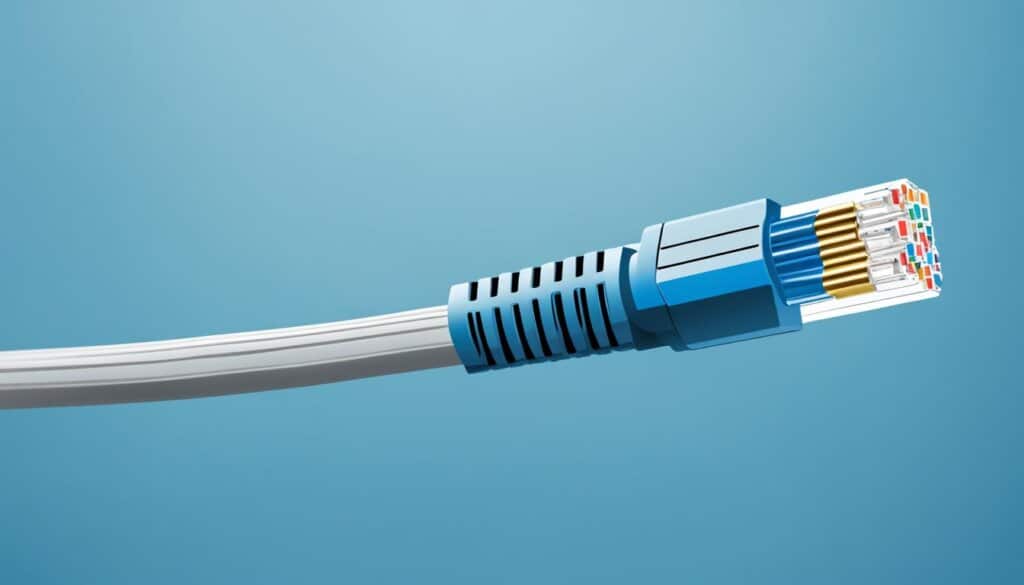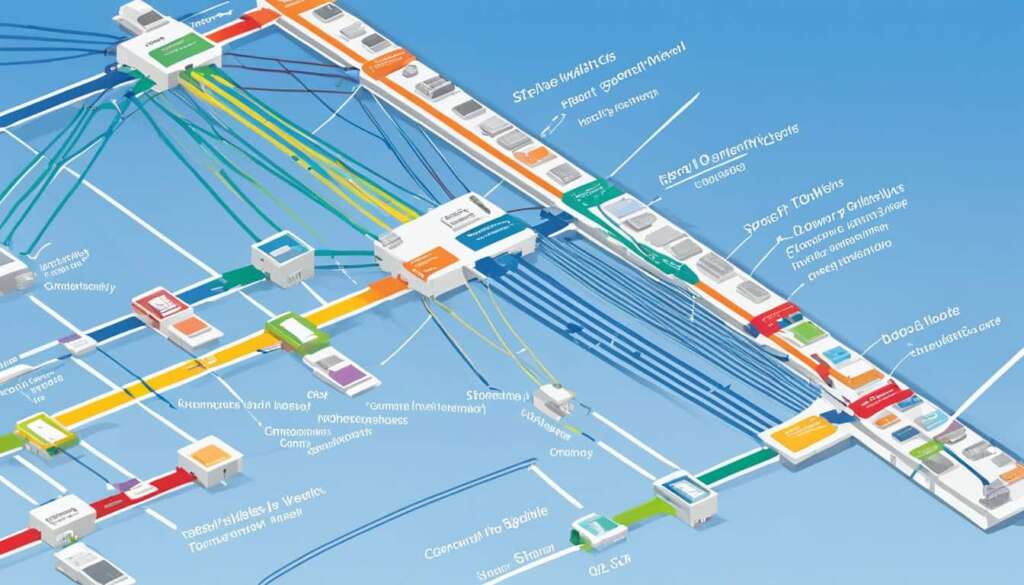Table of Contents
The OSI physical layer is a fundamental component in the world of data transmission and networks. It forms the first and lowest layer of the Open Systems Interconnection (OSI) model, which provides a framework for understanding how applications communicate over a network.
The OSI physical layer plays a vital role in ensuring efficient communication between devices. It is responsible for transporting data using various interfaces and technologies, acting as the foundation for data transmission in networks.
At the heart of its functionality, the physical layer determines how bits are converted into signals, sets the data rate, ensures synchronization between devices, and defines the transmission mode and interface. It encompasses the physical topology of the network, including the various physical layer protocols used for data transmission.
By understanding the role and importance of the OSI physical layer, we can delve deeper into how data flows within a network and how devices communicate seamlessly. So, let’s explore the functions, physical topologies, protocols, and significance of this crucial layer in the OSI model.
Functions of the Physical Layer
The physical layer of the OSI model performs several key functions that are vital for successful data transmission. From converting bits into signals to determining transmission modes and providing interfaces, the physical layer plays a crucial role in ensuring efficient communication between devices.
One of the primary functions of the physical layer is to convert bits into signals. This process ensures that data is represented reliably and predictably during transmission. By converting digital information into analog signals, the physical layer enables the transfer of data across different transmission media.
Another important role of the physical layer is to determine the data rate at which bits flow. It sets the pace for data transmission and ensures that information is efficiently transferred between devices. By defining the speed at which data travels, the physical layer plays a significant role in optimizing data transfer.
Synchronization is another critical function of the physical layer. It ensures that sending and receiving devices are in sync and able to understand each other’s signals. By establishing a common timing reference, the physical layer allows for seamless communication between devices and prevents data loss or corruption.
The physical layer also determines the transmission mode, which defines the direction and flow of data transmission. There are three modes: simplex, half-duplex, and full-duplex. In simplex mode, data can only flow in one direction. In half-duplex mode, data can flow in both directions but not simultaneously. In full-duplex mode, data can flow in both directions simultaneously. The physical layer establishes the appropriate transmission mode based on the network requirements.
Additionally, the physical layer provides the interface for connecting devices to the transmission medium. It defines the protocols and standards that enable devices to communicate and exchange data. The interface ensures seamless compatibility and connectivity between devices, allowing them to interact with the transmission medium effectively.
The physical layer is responsible for signal equalization, switching mechanisms, and modulation, which converts data into radio waves. These functions ensure that data is transmitted accurately and efficiently, overcoming any potential noise or interference in the transmission medium.
Overall, the physical layer’s functions are essential for effective data transmission. By converting bits into signals, determining the data rate, ensuring synchronization, defining the transmission mode, and providing interfaces, the physical layer plays a fundamental role in enabling successful communication between devices.
Physical Topology and Transmission Modes
The physical layer of a network encompasses the physical topology, which refers to how devices are interconnected, and the transmission modes that govern communication. Understanding these aspects is vital for designing and implementing efficient network infrastructures. Let’s explore the different physical topologies and transmission modes in detail.
Physical Topology
The physical topology of a network defines the arrangement of devices and cables. Various physical topologies include:
- Mesh Topology: In a mesh topology, devices are connected to each other in a decentralized manner, forming multiple interconnections. This topology ensures redundancy and efficient routing between devices.
- Star Topology: The star topology connects all nodes to a central hub or switch. Each device has a dedicated connection to the central hub, enabling easy management and fault isolation.
- Bus Topology: In a bus topology, multiple devices are connected through a single backbone cable. This topology simplifies installation and requires fewer cables, but a single break in the backbone can disrupt the entire network.
- Ring Topology: The ring topology forms a circular connection between nodes, where each device is connected to the next and the last one connects back to the first. This topology ensures equal data distribution and creates a fault-tolerant network.
- Tree Topology: The tree topology resembles a hierarchical structure, with multiple interconnected sub-networks. It enables efficient management and scalability.
- Hybrid Topology: The hybrid topology combines two or more topologies based on specific requirements, such as performance, reliability, or cost. It offers flexibility and can be tailored to suit unique network needs.
Image:
Transmission Modes
The physical layer defines different transmission modes that govern how data is sent and received between devices. These modes include:
- Simplex Mode: In simplex mode, communication is unidirectional, where only one node can transmit data while the other can only receive. This mode is ideal for applications that require a one-way flow of information.
- Half-Duplex Mode: Half-duplex mode allows both nodes to send and receive data, but not simultaneously. When one node is transmitting, the other acts as a receiver. This mode is commonly found in walkie-talkies and Ethernet networks.
- Full-Duplex Mode: Full-duplex mode enables simultaneous two-way communication, allowing both nodes to send and receive data concurrently. This mode is typically used in high-performance networks, such as modern Ethernet connections and fiber optic links.
The choice of transmission mode depends on factors like communication requirements, network infrastructure, and cost considerations.
Understanding the physical topology and transmission modes is crucial for network designers and administrators. By assessing the needs of the network and the desired performance, they can select the most appropriate topology and transmission mode to optimize communication efficiency and reliability.
Examples of Physical Layer Protocols
The physical layer is implemented using a combination of software and hardware programming. It includes various protocols that govern data communications at this layer.
Examples of physical layer protocols include:
- Ethernet: Ethernet is a widely used physical layer protocol that defines the standards for wired local area network (LAN) connections. Different specifications of Ethernet, such as 1000BASE-T and 100BaseTX, provide various data transmission speeds and cabling options.
- Synchronous Optical Networking (SONET): SONET is a physical layer protocol used for high-speed optical communication. It enables the transmission of large volumes of data over long distances by using optical fibers and standardized signaling rates.
- 802.11: The 802.11 family of physical layer protocols, commonly known as Wi-Fi, is used for wireless network communications. It includes different variants such as 802.11a, 802.11b, 802.11g, and 802.11n, each with its own data rates and frequency bands.
- Bluetooth: Bluetooth is a short-range wireless communication protocol used for connecting devices such as smartphones, laptops, and peripherals. It operates in the 2.4 GHz frequency range and provides reliable data transmission within a limited range.
- Universal Serial Bus (USB): USB is a popular physical layer protocol that facilitates the connection and communication between devices and computers. It supports high-speed data transfer and provides a standardized interface for a wide range of peripherals.
These protocols, along with others, provide the necessary rules and standards for data transmission at the physical layer, ensuring efficient communication between devices.

Physical Layer in the OSI Model
The physical layer is the fundamental layer in the OSI model, a conceptual framework used to comprehend how applications communicate over a network. Consisting of seven layers, the OSI model relies on the physical layer as its foundation. This layer primarily facilitates the transmission of data in its raw bit form over physical connections.
The physical layer addresses the mechanical, electrical, and procedural aspects of data transmission, serving as the interface between the higher layers and the physical medium. It plays a crucial role in enabling seamless communication between devices and is essential for understanding the process of sending and receiving data over a network.
By encoding bits into signals, ensuring synchronization, and defining the transmission mode and interface, the physical layer establishes the groundwork for efficient data transmission. Without a properly functioning physical layer, the higher layers of the OSI model would not be able to communicate effectively, resulting in disrupted network connectivity.
The physical layer is the backbone of the OSI model, providing the necessary foundation for seamless communication between devices. It handles the fundamental aspects of data transmission and enables devices to exchange information reliably over a network.
Conclusion: Importance of the OSI Physical Layer
The OSI physical layer plays a crucial role in facilitating efficient data transmission and network connectivity. As the first layer of the OSI model, it serves as the foundation for the entire network infrastructure. By defining the physical connections, transmission modes, and interfaces, the physical layer enables devices to communicate effectively across networks.
Efficient communication relies on the reliable and accurate transmission of data between devices. The OSI physical layer ensures that data is transported seamlessly, setting the groundwork for the higher layers to process and interpret the information. Without a robust physical layer, network connectivity and smooth data transmission would be compromised.
Furthermore, the physical layer contributes to the establishment of physical topologies, determining how devices are interconnected. Whether it’s a mesh, star, bus, ring, tree, or hybrid topology, the physical layer provides the necessary framework for network architecture. It also implements essential protocols for data transmission, such as Ethernet, Synchronous Optical Networking, 802.11, Bluetooth, and Universal Serial Bus, further enhancing network connectivity.
In conclusion, the OSI physical layer is a vital component of network infrastructure. It ensures efficient data transmission, fosters seamless communication between devices, and establishes reliable network connectivity. Without the solid foundation provided by the physical layer, networks would struggle to function effectively, hindering efficient communication in the digital world.
FAQ
What is the OSI physical layer?
The OSI physical layer is the first and lowest layer of the Open Systems Interconnection (OSI) model. It facilitates data transmission using various interfaces and technologies, providing the foundation for communication between devices in networks.
What are the functions of the physical layer?
The physical layer performs several important functions in data transmission, including converting bits into signals, ensuring a reliable bit representation, determining the data rate, synchronization between devices, defining the transmission mode and interface, and playing a role in signal equalization, switching mechanisms, and modulation.
What are physical topologies and transmission modes?
Physical topologies refer to how devices are interconnected in a network. Examples include mesh, star, bus, ring, tree, and hybrid topologies. Transmission modes determine how nodes can send and receive data. It includes simplex mode where only one node can transmit, half-duplex mode where both nodes can send and receive but not simultaneously, and full-duplex mode where both nodes can send and receive simultaneously.
What are some examples of physical layer protocols?
Examples of physical layer protocols include Ethernet (such as 1000BASE-T and 100BaseTX), Synchronous Optical Networking, different variants of 802.11 for wireless networks, Bluetooth, and Universal Serial Bus (USB).
How does the physical layer fit into the OSI model?
The physical layer is the first layer in the OSI model and serves as the foundation for the other layers. It deals with the mechanical, electrical, and procedural aspects of data transmission, providing the interface between the higher layers and the physical medium.
Why is the OSI physical layer important?
The OSI physical layer is crucial for efficient data transmission and network connectivity. It enables seamless communication between devices by defining physical connections, transmission modes, and interfaces, establishing physical topologies, and implementing protocols for data transmission.












